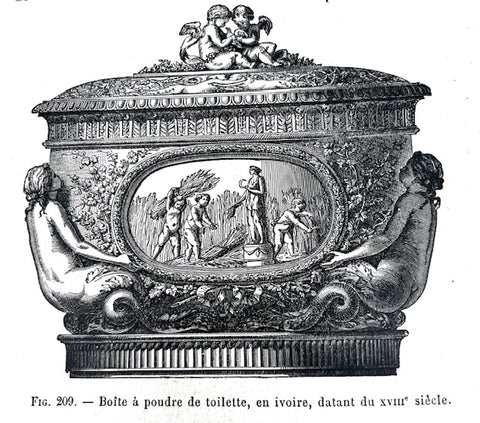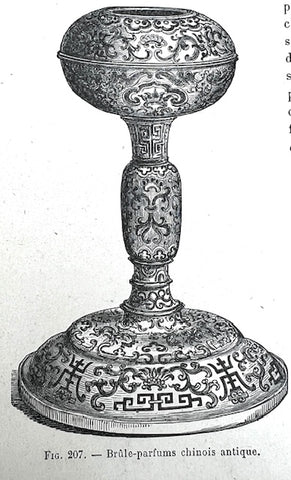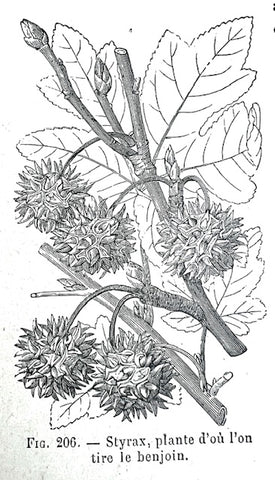History of perfume
Subtle perfumes, light fragrances, sublime scents.
The use of perfumes originates from India and Persia, rich in aromatics, and was much more common among all nations in antiquity than it is today among us. Perfumery was a very important branch of industry for them. Several essential oils were already known in their pure state (such as lemon, laurel, turpentine); but their cosmetic and fragrant compositions were solutions of essences in fatty oils obtained by macerating aromatic substances: myrrh, cinnamon, cardamom, calamus, saffron, rose, narcissus, lily, sweet clover, marjoram, iris, styrax, in olive, sesame, and benzoin oils. These fragrant oils were usually colored with cinnabar and alkanna. They were protected from contact with air and heat. Several cities had a great reputation for the excellence of the products of this kind they manufactured, such as Mendes in Egypt, Tyre in Phoenicia, Soli in Cilicia, Corinth, Rhodes, Cos, Cyprus in Greece, Naples, Capua, Préneste (Palestrina) in Italy.

In Egypt, aromatics were first used in religious rites; the priests of Heliopolis offered three kinds of perfumes prepared in temples to their god every day: resin, myrrh, and a compound called kuphi. From the worship of the gods, the use of perfumes passed to that of the dead, whose bodies were embalmed: the corpses, completely disemboweled, were filled with myrrh, cinnamon, and other perfumes, then immersed for seventy days in a natron bath to completely destroy any germ of corruption. This cost the trifling sum of 1 talent (5000 francs); for the common people, salt and natron replaced the perfumes and aromatics.

Perfumes in the everyday life of societies
Soon, perfumes became part of the habits of daily life; they were used for women's toilettes, luxury, and the enjoyment of festivities. Banquet halls were strewn with flowers; fragrant braids adorned the walls and twisted above the cups; on tables, sweet resins burned in rich incense burners as seen today in many oriental peoples.
The vase we depict, in cloisonné enamel, elegant in shape, is charming with colors and harmony rarely found in modern Chinese productions, where grotesque seems to be sought rather. The ornaments are surrounded by a gold thread; their field is cobalt green, blood red, ultramarine blue, soft lilac, and black. The background is a slightly pale blue. It belongs to Mr. Gon's collection from La Rochelle.
Upon entering, guests received waves of essence for their wigs from slaves assigned to this task (almost all were shaved); then a garland of lotus mixed with crocus and saffron was placed around their necks.
The Hebrews brought the use of perfumes from Egypt, including nard, incense, myrrh, saffron, aromatic cane, and aloes. The aloes of the Bible is a shrub abundant throughout the East, and its highly aromatic wood is the main ingredient in the scented sticks burned in temples by the Chinese and Indians.
Asian kings made great use of perfumes. Babylon was for a long time the main warehouse for aromatics from all over the world.
It received spices from India and the Persian Gulf, fragrant gums from Arabia, and precious balms from Judea.
Perfumes were well known in Homer's time. Hesiod recommended them for divine worship. In Greece, perfumery played a significant role in medicine; perfumeries were meeting places, much like cafes are today.

Perfumery in the Romans period and modern Europe.
The Romans, inheriting the riches of the Greek and Asian world, also inherited its effeminate habits. Under the Roman emperors, the love of perfumes was taken so far that it even penetrated into the military camps, as the legion eagles were scented on feast days. During theatrical performances, ingeniously arranged narrow pipes released a sweet saffron-scented mist that rose to a considerable height and fell on the spectators. In Gaul, not favored in balsamic products, the druids scented their altars with some onagraceae, resinous woods, or juniper berries.
In modern Europe, perfumes were initially, as in ancient times, used exclusively for worship. The Crusaders were the first to introduce their use into domestic life.
It was Catherine de Medici who popularized the use of perfumes in France, mainly derived from Italy, although there were already some French perfumers, and during the Renaissance, it took on considerable importance. It was during this period that works by Saigini, Guet, Dettuzy, Isabella Corteze, and Marinollo were published on cosmetics, all treating this art in a remarkable manner.
Neglected under Henry IV, who cared little for them, perfumes regained popularity during the effeminate reign of Louis XIII. However, Louis XIV prohibited them.
Under the reign of Louis XV, the perfume trend became a true epidemic; Versailles acquired the name of the perfumed court. Perfumery, swept away during the Revolution, reappeared during the Directory and regained all its importance thanks to Josephine de Beauharnais.

